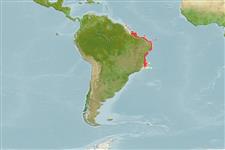Common names from other countries
>
Acanthuriformes (Surgeonfishes) >
Acanthuridae (Surgeonfishes, tangs, unicornfishes) > Acanthurinae
Etymology: Acanthurus: Greek, akantha = thorn + Greek, oura = tail (Ref. 45335).
More on author: Poey.
Issue
Sister species: Acanthurus bahianus (Ref. 087362).
Environment: milieu / climate zone / depth range / distribution range
Ecologia
marinhas associadas(os) a recifes; intervalo de profundidade 11 - 45 m (Ref. 3194). Tropical; 21°C - 25°C (Ref. 27115); 44°N - 7°N, 98°W - 59°W (Ref. 87362)
Northwest to West Central Atlantic: from Massachusetts and Bermuda to Trinidad and Tobago, including the Gulf of Mexico and the islands of the Caribbean.
Comprimento de primeira maturação / Tamanho / Peso / Idade
Maturity: Lm 15.5, range 9 - ? cm
Max length : 38.1 cm SL macho/indeterminado; (Ref. 9761); common length : 25.0 cm TL macho/indeterminado; (Ref. 3142)
Espinhos dorsais (total) : 9; Raios dorsais (total) : 23 - 26; Espinhos anais: 3; Raios anais : 21 - 23. This species is distinguished by the following set of characters: D IX, 23-26; A III, 21-23; pectoral rays 15-17; gill rakers 18-24; covered with very small ctenoid scales; spatulate teeth have denticulate edges, upper jaw with 14, lower jaw 16; body depth about 2.0 in standard length; caudal fin lunate, concavity of caudal fin 5.0-12.0 in SL, more concave in adults; length of caudal spine 3.0-3.5 in SL; eye diameter 3.0-3.5 in head length; colour of body yellowish to grayish brown, without dark vertical bars; yellow lines radiating from the posterior margin of eye; translucent pectoral fin with yellow tints; white or pale spot at the base of caudal fin; posterior margin of caudal, anal and dorsal fins have light blue or white margin (Ref. 87362)..
Inhabits shallow bottoms with coral or rocky formations (Ref. 13628); also found around inshore rocky areas with patches of sand, feeding primarily on benthic algae and occasionally grazing on seagrass beds (Ref. 87362). Usually occurs in groups of five or more individuals. Mainly diurnal species. The spine on both sides of the caudal peduncle may inflict painful wounds (Ref. 5217). Marketed fresh. Minimum depth reported from Ref. 27115. Previously reported longevity of 31 years from Ref. 52229 refers to Acanthurus bahianus, a case of misidentification.
Ciclo de vida ou comportamento de acasalamento
Maturities | Reprodução | Spawnings | Egg(s) | Fecundities | Larvas
Bernal, M.A. and L.A. Rocha, 2011. Acanthurus tractus Poey, 1860, a valid western Atlantic species of surgeonfish (Teleostei, Acanthuridae), distinct from Acanthurus bahianus Castelnau, 1855. Zootaxa 2905:63-68. (Ref. 87362)
Status na Lista Vermelha da UICN (Ref. 130435)
CITES (Ref. 128078)
Not Evaluated
Ameaça para os humanos
Traumatogenic (Ref. 5217)
Uso pelos humanos
Pescarias: pouco comercial; Aquário: Espécies comerciais; isca: occasionally
Ferramentas
Relatórios especiais
Baixar XML
Fontes da internet
Estimates based on models
Preferred temperature (Ref.
115969): 22.9 - 28, mean 26.6 (based on 426 cells).
Índice de diversidade filogenética (Ref.
82804): PD
50 = 0.5000 [Uniqueness, from 0.5 = low to 2.0 = high].
Bayesian length-weight: a=0.01950 (0.01244 - 0.03056), b=2.91 (2.78 - 3.04), in cm Total Length, based on LWR estimates for this species & Genus-body shape (Ref.
93245).
Nível Trófico (Ref.
69278): 2.0 ±0.0 se; based on diet studies.
Resiliência (Ref.
120179): Muito baixo(a), tempo mínimo de duplicação da população maior que 14 anos (K=0.3-1.5; tmax=31).
Fishing Vulnerability (Ref.
59153): Low to moderate vulnerability (32 of 100).
